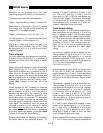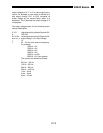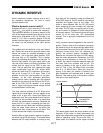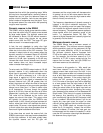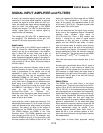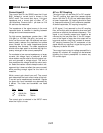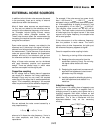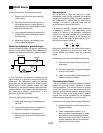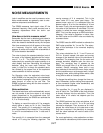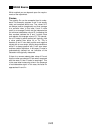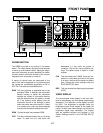
3-22
SR850 Basics
Current Input (I)
The current input on the SR850 uses the A input
BNC. Voltage or current input is chosen in the
INPUT menu. The current input has a 1 kΩ input
impedance and a current gain of either 10
6
or
10
8
Volts/Amp. Currents from 1 µA down to 2 fA
full scale can be measured.
The impedance of the signal source is the most
important factor to consider in deciding between
voltage and current measurements.
For high source impedances, greater than 1 MΩ
(10
6
gain) or 100 MΩ (10
8
gain), and small cur-
rents, use the current input. Its relatively low impe-
dance greatly reduces the amplitude and phase
errors caused by the cable capacitance-source
impedance time constant. The cable capacitance
should still be kept small to minimize the high fre-
quency noise gain of the current preamplifier.
For moderate to low source impedances, or larger
currents, the voltage input is preferred. A small
value resistor may be used to shunt the signal cur-
rent and generate a voltage signal. The lock-in
then measures the voltage across the shunt resis-
tor. Select the resistor value to keep the shunt volt-
age small (so it does not affect the source current)
while providing enough signal for the lock-in to
measure.
Which current gain should you use? The current
gain determines the input current noise of the lock-
in as well as its measurement bandwidth. Signals
far above the input bandwidth are attenuated by
6 dB/oct. The noise and bandwidth are listed
below.
Gain Noise Bandwidth
10
6
130 fA/√Hz 70 kHz
10
8
13 fA/√Hz 700 Hz
The current gain is selected in the INPUT menu
when the I input is in use.
AC vs DC Coupling
The signal input can be either AC or DC coupled.
The AC coupling high pass filter passes signals
above 160 mHz (0.16 Hz) and attenuates signals
at lower frequencies. AC coupling should be used
at frequencies above 50 mHz whenever possible.
At lower frequencies, DC coupling is required.
A DC signal, if not removed by the AC coupling
filter, will multiply with the reference sine wave and
produce an output at the reference frequency. This
signal is not normally present and needs to be
removed by the low pass filter. If the DC compo-
nent of the signal is large, then this output will be
large and require a long time constant to remove.
AC coupling removes the DC component of the
signal without any sacrifice in signal as long as the
frequency is above 160 mHz.
The current input current to voltage preamplifier is
always DC coupled. AC coupling can be selected
following the current preamplifier to remove any
DC current signal.



